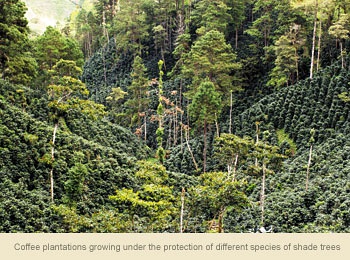Guatemala Coffee planting Environment Guatemala Coffee cultivation
Faced with severely altered landscapes and shrinking habitats, more than ninety migratory bird species have found refuge on shade trees. In early autumn (the northern temperate zone), birds such as the Nashville warbler (Vermivora ficapilla), the broad-winged eagle (Buteo sailfish), the cockatoo flycatcher (Myiarchus crinitus), the lovely summer tanager (piranga), the Raptors and others frequently shade coffee.
In Guatemala, migratory birds are found surviving on coffee farms in different ecosystems. leguminous tree like "cuje." The types of "palaeo-N," and "chalum"(genus Inga), used as the main shade trees in Guatemala, are beneficial not only to coffee plants, but also to migratory birds foraging for birds, attracted from the nectar of flowers or from the flowers of insects. Other species of trees, bromeliads, orchids and ferns that accompany epiphytes enhance the overall biodiversity of coffee farms, providing shelter and resources for birds and other animals.
In addition to migratory birds, the eastern mountain forests and coffee farms are home to more than a hundred resident birds, such as the crescent wabler(forest superciliosa), the masked pheasant (mottled pheasant semifasciata), the tropical golden broad (tyrannus melancholy), and the common bush tanager. A shadow coffee system, while unable to replicate the dynamics of natural forests, could provide surprisingly high quality habitat for many of these birds.
In the east, the shadow of coffee farms forms a bridge between natural forests, joining these residual patches and providing complementary habitat, the landscape having been severely altered by human intervention. Without these basic habitats, birds would seek refuge in areas facing greater challenges, feeding and nesting.

Important Notice :
前街咖啡 FrontStreet Coffee has moved to new addredd:
FrontStreet Coffee Address: 315,Donghua East Road,GuangZhou
Tel:020 38364473
- Prev

An Englishman who loves coffee vs afternoon tea. Boutique coffee
A touch of English coffee is becoming more and more popular in Britain. The first British Coffee week (UK Coffee Week) kicked off in London this week. With the strong aroma of coffee beans and the sunshine of British spring, coffee lovers can enjoy the comfort and joy of coffee. Walking in the streets of London, the smell of freshly ground coffee is filled with beans.
- Next

One of the more sour varieties of Guatemalan coffee
Guatemalan coffee, produced in Guatemala, belongs to bourbon coffee beans, is one of the more sour varieties, mellow and slightly wild taste, the most suitable for blending coffee. History a cup of Antigua coffee in Guatemala seems to let us see the sudden disappearance of the mysterious Mayans thriving in the ancient land, history brushed away their existence.
Related
- Detailed explanation of Jadeite planting Land in Panamanian Jadeite Manor introduction to the grading system of Jadeite competitive bidding, Red bid, Green bid and Rose Summer
- Story of Coffee planting in Brenka region of Costa Rica Stonehenge Manor anaerobic heavy honey treatment of flavor mouth
- What's on the barrel of Blue Mountain Coffee beans?
- Can American coffee also pull flowers? How to use hot American style to pull out a good-looking pattern?
- Can you make a cold extract with coffee beans? What is the right proportion for cold-extracted coffee formula?
- Indonesian PWN Gold Mandrine Coffee Origin Features Flavor How to Chong? Mandolin coffee is American.
- A brief introduction to the flavor characteristics of Brazilian yellow bourbon coffee beans
- What is the effect of different water quality on the flavor of cold-extracted coffee? What kind of water is best for brewing coffee?
- Why do you think of Rose Summer whenever you mention Panamanian coffee?
- Introduction to the characteristics of authentic blue mountain coffee bean producing areas? What is the CIB Coffee Authority in Jamaica?

